
|   |

|   |
Engaging performances at Catalyst and Nirmohi - Vijay Shanker e-mail: vijaydance@gmail.com August 19, 2022 NCPA showcased three selected dancers, who had ventured out to do some innovative choreography during the lockdown. The dancers invited were Kuchipudi dancer Parvathy Menon, disciples of Odissi exponent and mentor Shubhada Varadkar and Kathak dancer from Ahmedabad, Sanjukta Sinha. While the dancers were trying to reach out with their presentations, Sanjukta Sinha and her group stood out for the vivacious quality of her performance, blending well with rhythmic precision, portraying a secular perspective. The program was held on 21st July at NCPA Experimental theatre. 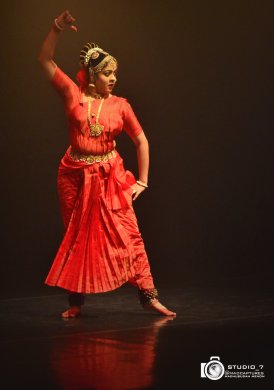 Parvathy Menon Parvathy Menon is one of the foremost disciples of Kalamandalam Mohana Thulasi and veteran mentor, AB Bala Kondala Rao. Parvathy presented "Jyotir gamaya" (towards light) incorporating the composition "Chinni Krishna Ra Ra" - pertaining to the inner awakening, vital to transcend the flux of life, through the persona of Devaki, mother of Krishna. The number commences with the birth of Krishna in the karagriha (prison), moving away from the prison to escape the vicious attention of Kansa, the childhood pranks and his leelas at Gokul with the finale 'Geetopadesham' at Kurukshetra. Parvathy succeeds in interpreting the sancharis and episodes in fleeting expressions and movements, interwoven with some pure dance sequences that was complex but interesting. Blessed with charming features, Parvathy is capable of doing much better; she needs to concentrate on the finer aspects of dancing, pertaining to the completion of movements, while maintaining the elegance and dexterity. 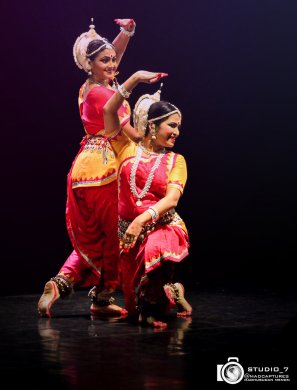 Mitali Varadkar and Shreya Sabharwal Foremost disciples of accomplished Odissi exponent Shubhada Varadkar, Mitali Varadkar and Shreya Sabharwal presented choreography which was done during the lockdown. Mitali explained that due to the lockdown they could not meet and it was through online sessions that the choreography was executed, which was rather difficult and tedious. Mitali and Shreya commenced with Ram Stuti based on Tulsidas Ramayan, followed with Jinjhoti Pallavi that exposed intricate and stylized movements that forms the hallmark of Odissi dancing. While both Mitali and Shreya are quite charming and make a fine duo, the lyrical and subtle nuances of the feminine style of dancing could be more enhanced. Shive Sringara, a composition of Adi Shankaracharya, exposed the goddess and the concept of both Shiva and Shakti with references to the killing of the demon Mahisasura, a short and dramatic exposition with commendable angika abhinaya. 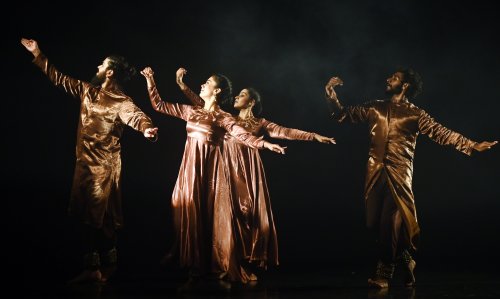 Sanjukta Sinha and group The finale performers of the evening Sanjukta Sinha and her troupe of dancers, literally put the stage on fire with their vibrant and vivacious performance inclusive of two male dancers Pankaj Sihag (contemporary dancer) and Vihang Rukshan from Sri Lanka and two female dancers Krutika Ghanekar and Vidhi Shah. Commencing with Mahadeva Shiva Shankara, the dancers were mostly attired in black and dark brown costume, depicting the stark, esoteric and mystic quality of the Lord with percussion music that was quite effective to enhance the complex and rhythmic footwork. They danced in musical interludes, exposing both male and female power in harmony that caught the rapt attention of the audience. Movements, expressions with a secular philosophy of reaching out to the supreme in the Sufi style was the grand finale, proclaiming "Duniya ka har cheez, ham tum par nichavar kar de" (We surrender everything we have to you, Almighty). After the performance, a post discussion was held moderated by Bharatanatyam exponent Lata Surendra. The dancers revealed the problems they faced, how difficult it was to keep their passion alive with varied restrictions but managed to move on with online sessions, phone calls, zoom meetings etc. Sanjukta narrated that her company was established recently and the dancers were from different styles, hence to work together was not easy but hard work always pays. On the whole, the Catalyst program was interesting to watch innovative choreography with different perspectives. Tribute to mentors through the poetic renderings of saint poets Kabir and Meera Kaishiki Nrityabhasa and Bhavan's Cultural Centre, on the occasion of Guru Purnima, presented a unique program of music and dance known as 'Nirmohi' through the medium of poetic renderings of eminent saint poets Kabir and Meera, at SP Jain auditorium, Mumbai on 2nd July. The program was unique as it combined philosophy, religion, spirituality, values of life with aesthetic sensibility. Kabir Das (1398-1518) was a 15th century mystic poet and saint who was largely influenced by the Hinduism Bhakti movement of medieval India. His verses are found in Sikhism, Guru Granth Sahib, Satguru Granth Sahib and Saint Garib Das and Kabir Sagar. He was influenced by both Hinduism and Islam, though he was critical of certain aspects of both the faiths. Meera was the saint poetess of Rajasthan, who was completely devoted to Lord Krishna. As a child, her mother gifted her with an idol of Lord Krishna and she was told that 'Krishna is your friend and will always protect you' and she completely believed in her mother. She defied the social norms of marriage and did not keep any marital relationship with her husband and she was considered a lunatic. Meera was so obsessed with her devotion for Krishna that she consistently sang and danced to the poetic renderings written by her. Meera faced adversity but rose victorious due to her dedication for her Lord. The program commenced with the welcome address by Odissi exponent Daksha Mashruwala, who briefly introduced the significance of the event and the singer of the evening, Anita Kukarni. Anita is a professional architect based in USA but is quite passionate about music and has established Renu Foundation for Arts for art education and spiritual development through the medium of literature, music and dance, particularly 'Kabir Bani', the language of the saint poet Kabir which is fine mix of dialects and languages like Hindi, Braj bhasa, Khadi boli, Urdu, Marwadi etc as his poetry was greatly influenced by both Hinduism and Islamism and he travelled widely all over India, thereby being influenced by regional differences and social norms that he confronted. He was religious but did not follow any particular religion as he followed secularism. The first poetic rendering of the evening was "Sadho ye tan" wherein Kabir refers to body as the musical instrument tanpura and the strings are the breathing that resonates with music and life; if the strings are broken, you are shattered, hence it's important to maintain the harmony of life. In the second rendering, Kabir interprets the philosophy of devotion to the formless (nirguna) and sings in praise of the Almighty, "Nirbhaya, nirgunaye, Gun re gaunga" (Fearlessly I sing in praise of the formless). Anita was accompanied on tabla by Vedant Lele and harmonium by Tanmay Mistry. 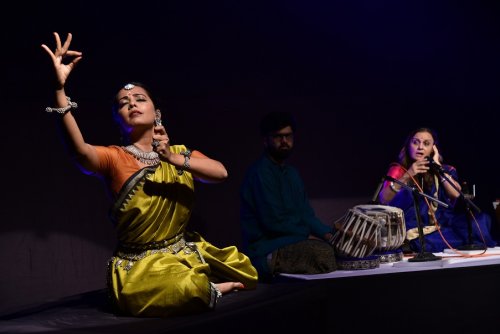 Namrata Mehta and Anita Kulkarni The third rendering was the Meera bhajan "Chalawahede ho Pritam" which was rendered in Odissi for the first time in the Baithak style, wherein the dancer interprets, while sitting, through expressions and hastas expressing Meera's longing for Krishna. Meera's consciousness is immersed with Krishna, to the extent that she sees and feels Krishna in fragrance of flowers, in the peacock, in the birds singing or his melodious flute, she wonders where he is, in nature or within herself… this state of emotion was exquisitely expressed through sancharis and netra bhava by accomplished Odissi exponent Namrata Mehta. Namrata said, "This interpretation is based on the teachings of Guru Kelucharan Mohapatra and my Guru Daksha Mashruwala and this is for the first time it's in the Baithak style." Another beautiful poetic interpretation of Kabir, "Aap hi dandi, Aap hi tarazu. Sab may, Sab jag mein aap hi viraje" proclaiming the philosophy of oneness in nature, the poet says that the Almighty can be seen in the stick, in the weighing machine, in nature and everywhere, depicted with subtle expressions by charming Kathak dancer Sarita Kalele, disciple of Uma Dogra. 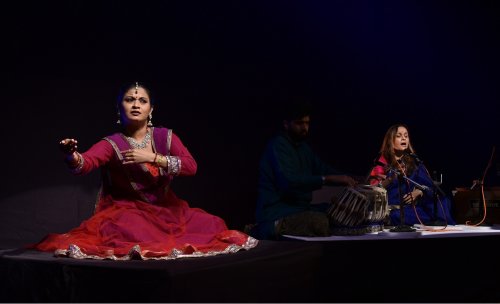 Sarita Kalele and Anita Kulkarni The finale renderings "Gurugyani" depicted the message that it is the mentor who can guide you and channelise your thoughts for spiritual upliftment and enlightenment. Lastly, Kabir aptly said "Dukh may sumiran sab kare, sukh mein kare na koi, jo sukh may sumiran kare, toh dukh na paye" (We remember God only when we are sad or helpless; we never think of God when we are happy; if we pray to God always, we will never be unhappy). It was indeed a unique program of soulful musical renderings by Anita Kulkarni and dance interpretations reaching out to the supreme power. 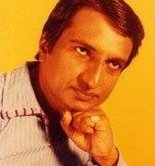 Vijay Shankar is a Kuchipudi and Kathakali exponent, teacher, bilingual journalist, arts critic and actor. |